|
Lockheed P-38J Lightning
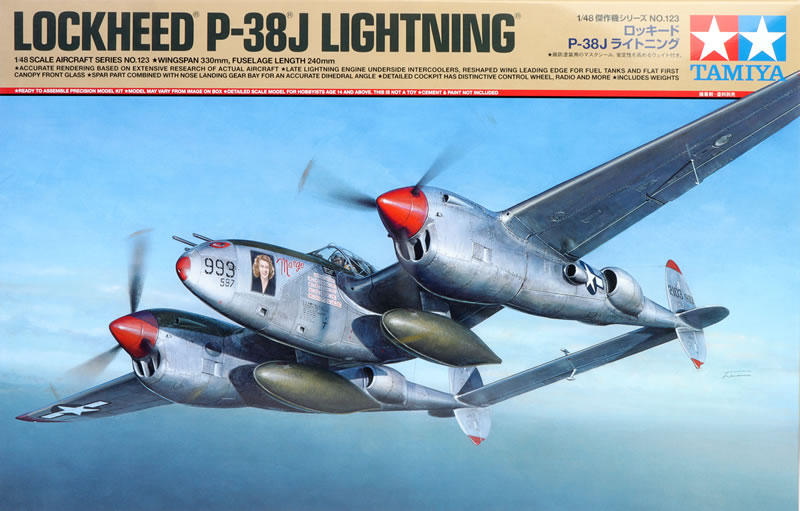
Tamiya, 1/48 scale
S
u m m a r y |
| Catalogue Number: |
Tamiya Kit No. 61123 - Lockheed P-38J Lightning |
| Scale: |
1/48 |
| Contents and Media: |
229 parts in grey coloured plastic; 14 parts in clear; self-adhesive canopy masks; three large chrome ball bearings; markings for three aircraft. |
| Price: |
£64.99 UK Price (£54.16 Export Price) plus shipping at Hannants
and hobby retailers worldwide |
| Review Type: |
FirstLook |
| Advantages: |
Clever and modeller-friendly design; excellent detail throughout; crisp and restrained surface textures; nice seated pilot figure; includes self-adhesive canopy masks. |
| Disadvantages: |
|
| Conclusion: |
Tamiya has once again woven its magic, expanding its Lightning family to include the definitive P-38J model.
Tamiya's forerunners from Hasegawa, Academy and Monogram have all been notoriously difficult to build. Tamiya, however, has a happy knack for producing a kit that looks good on the sprues but gets even better when you start building it. This one is no exception. Having built the previous P-38F/G release, I can assure you from first hand experience that assembly will be a pleasure.
There is nothing fancy about this kit - no engine to display, photo-etch or moving parts. What we have instead is a delightfully detailed and accurate model that will go together without any drama.
Detail in the wheel wells is some of the best that I have seen anywhere. The cockpit also looks significantly better assembled than it does flat on the sprues.
There are plenty of inserts but don't be alarmed - fit is perfect. You will be hard pressed to pick a join line from a recessed panel line.
Tamiya's new 1/48 scale P-38J Lightning is a worthy replica of this beautiful aeroplane. You can be confident that the kit will line up perfectly and fit together without any resistance too! |
Reviewed by Brett Green

Background
The Lockheed P-38 Lightning is an American World War II two-engined fighter aircraft.
Developed for the United States Army Air Corps, the P-38 had distinctive twin booms and a central nacelle containing the cockpit and armament.
Allied propaganda claimed it had been nicknamed the fork-tailed devil (German: der Gabelschwanz-Teufel) by the Luftwaffe and "two planes, one pilot" by the Japanese.
The P-38 was used for interception, dive bombing, level bombing, ground attack, night fighting, photo reconnaissance, radar and visual pathfinding for bombers and evacuation missions, and extensively as a long-range escort fighter when equipped with drop tanks under its wings.

The P-38 was used most successfully in the Pacific Theater of Operations and the China-Burma-India Theater of Operations as the aircraft of America's top aces, Richard Bong (40 victories), Thomas McGuire (38 victories) and Charles H. MacDonald (27 victories).
In the South West Pacific theater, the P-38 was the primary long-range fighter of United States Army Air Forces until the appearance of large numbers of P-51D Mustangs toward the end of the war.
The P-38 was unusually quiet for a fighter, since the exhaust was muffled by the turbo-superchargers. It was extremely forgiving and could be mishandled in many ways but the rate of roll in the early versions was too low for it to excel as a dogfighter.
The P-38 was the only American fighter aircraft in large-scale production throughout American involvement in the war, from Pearl Harbor to Victory over Japan Day.
P-38J Lightning
The P-38J was introduced in August 1943. The turbosupercharger intercooler system on previous variants had been housed in the leading edges of the wings and had proven vulnerable to combat damage and could burst if the wrong series of controls was mistakenly activated. In the P-38J series, the streamlined engine nacelles of previous Lightnings were changed to fit the intercooler radiator between the oil coolers, forming a "chin" that visually distinguished the J model from its predecessors. While the P-38J used the same V-1710-89/91 engines as the H model, the new core-type intercooler more efficiently lowered intake manifold temperatures and permitted a substantial increase in rated power. The leading edge of the outer wing was fitted with 55 US gal (210 l) fuel tanks, filling the space formerly occupied by intercooler tunnels, but these were omitted on early P-38J blocks due to limited availability.
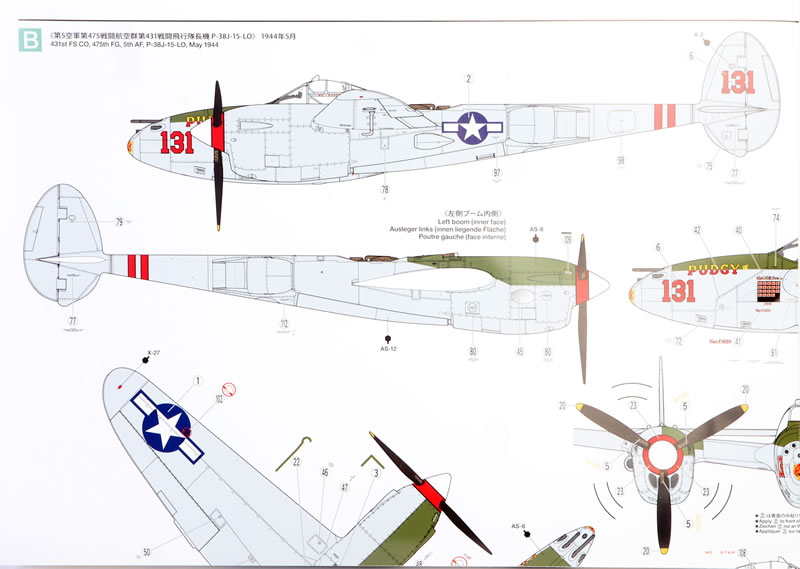
The final 210 J models, designated P-38J-25-LO, alleviated the compressibility problem through the addition of a set of electrically actuated dive recovery flaps just outboard of the engines on the bottom centreline of the wings. With these improvements, a USAAF pilot reported a dive speed of almost 600 mph (970 km/h), although the indicated air speed was later corrected for compressibility error, and the actual dive speed was lower. Lockheed manufactured over 200 retrofit modification kits to be installed on P-38J-10-LO and J-20-LO already in Europe, but the USAAF C-54 carrying them was shot down by an RAF pilot who mistook the Douglas transport for a German Focke-Wulf Condor. Unfortunately, the loss of the kits came during Lockheed test pilot Tony LeVier's four-month morale-boosting tour of P-38 bases. Flying a new Lightning named Snafuperman, modified to full P-38J-25-LO specifications at Lockheed's modification centre near Belfast, LeVier captured the pilots' full attention by routinely performing manoeuvres during March 1944 that common 8th Air Force wisdom held to be suicidal. It proved too little, too late, because the decision had already been made to re-equip with Mustangs.
The P-38J-25-LO production block also introduced hydraulically boosted ailerons, one of the first times such a system was fitted to a fighter. This significantly improved the Lightning's rate of roll and reduced control forces for the pilot. This production block and the following P-38L model are considered the definitive Lightnings, and Lockheed ramped up production, working with subcontractors across the country to produce hundreds of Lightnings each month.
At the end of the war, orders for 1,887 more were cancelled.*
The P-38 Lightning in 1/48 scale
Tamiya debuted their 1/48 scale Lightning family with their P-38F/G in 2019.
Prior to that, there has been no shortgage of 1/48 scale P-38 Lightning kits.
Monogram released their initial 1/48 scale P-38 Lightning kit in 1964. That makes it nearly as old as I am! This was hailed as a great kit in its day, but time has taken its toll on the mouldings. Even so, it is still widely available and is ocassionally re-released.
Hasegawa's debut 1/48 scale P-38J Lightning was launched in 1993 - more than 25 years ago. This was a good kit for its day but it quickly earned a reputation for being diffcult to build, especially aligning the booms and wings.
Academy was up next in the very same year with their 1/48 scale Lightning. Detail was not up to the same standard as Hasegawa and once again it proved to be a difficult kit to build.
Both Hasegawa and Academy eventually released a wide range of variants from the P-38E to the P-38L and most of the family in between.
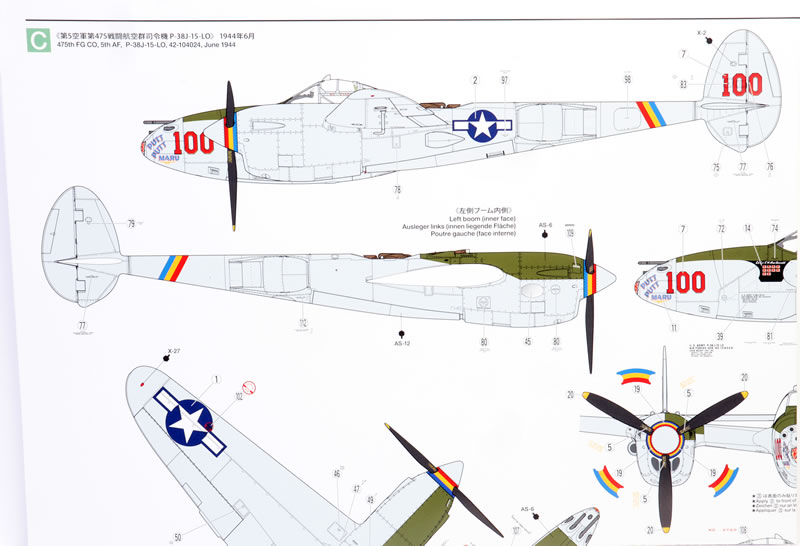
Minicraft also released several 1/48 scale P-38 variants. I recall at the time that there was some confusion about whether these were an original kits or re-pops of the Academy Lightnings, and I'm still sure of the final conclusion.
In 2014, Hobby Boss broke the Lightning drought with a new 1/48 scale kit. Sadly, despite clever enginering for assembly of the main parts, that kit suffered from a long list of inaccuracies and shortcomings. Check out Lynn Ritger's review on HyperScale for full details.
Regardless, it is now more than a quarter of a century since Hasegawa released 1/48 scale Lightning kit; and those currenty on the market are challenging to build, to say the least, or deeply flawed.
I have never built Hasegawa's or Academy's 1/48 scale Lightning kits due to their widespread reputation for difficult alignment and poor fit.
Tamiya has changed all that.
Tamiya's latest 1/48 scale Lightning kit is the definitive P-38J version.
This is no simple reboxing. Out of the nine sprues in the P-38F/G kit, only four are used here. Five of the new sprues specific to the P-38J are in grey plastic and one is clear.
In total, the new kit comprises 229 parts in grey coloured plastic, 14 parts in clear, self-adhesive canopy masks, three large chrome ball bearings and markings for three aircraft.
Surface texture is everything we expect to see on a Tamiya 1/48 scale new release - crisp and subtly recessed panel lines with some selected rivets as appropriate.

Options are relatively spare this time around, with just the choice of ferry tanks and standard Lockheed drop tanks.
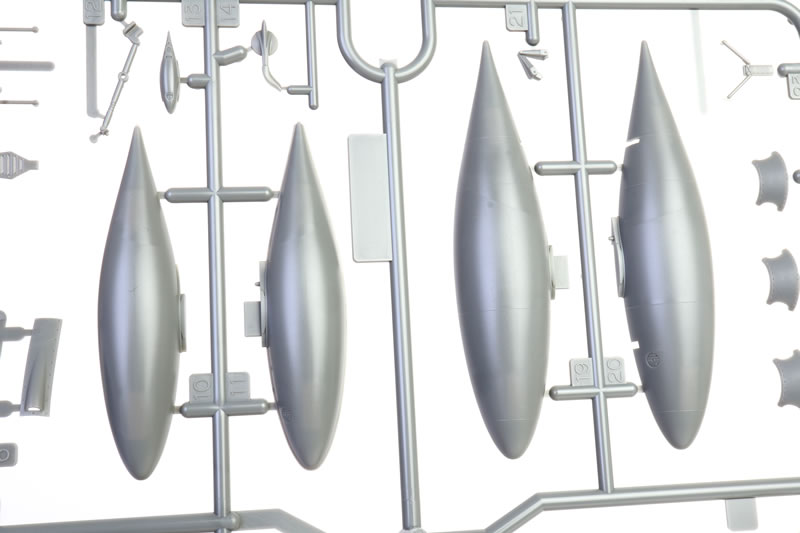
Parts breakdown reflects the unusual configuration of the aircraft and appear to be designed to ensure precise alignment. The upper wings and the top of the centreline fuselage pod are moulded as a single full span part. The entire nose in front of the windscreen is designed to be covered by two parts over the top and the sides.
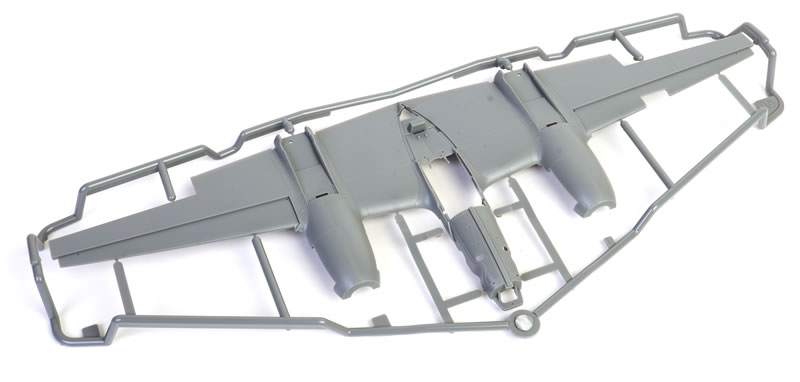
The lower half of the fuselage pod is moulded with the inboard lower wing secttons.
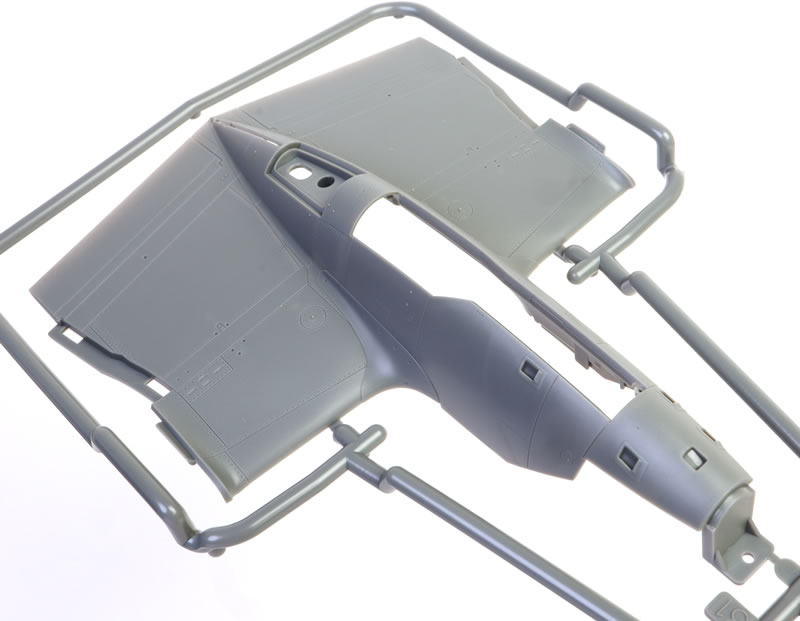
A long wing spar extends either side of the roof of the nose wheel well. This will ensure perfect dihedral.
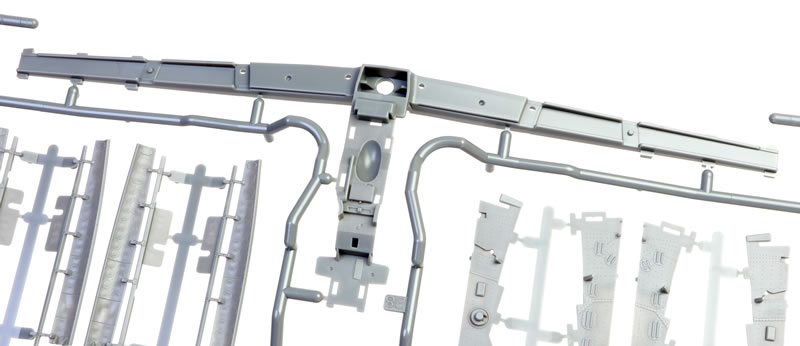
Cockpit detail is good.
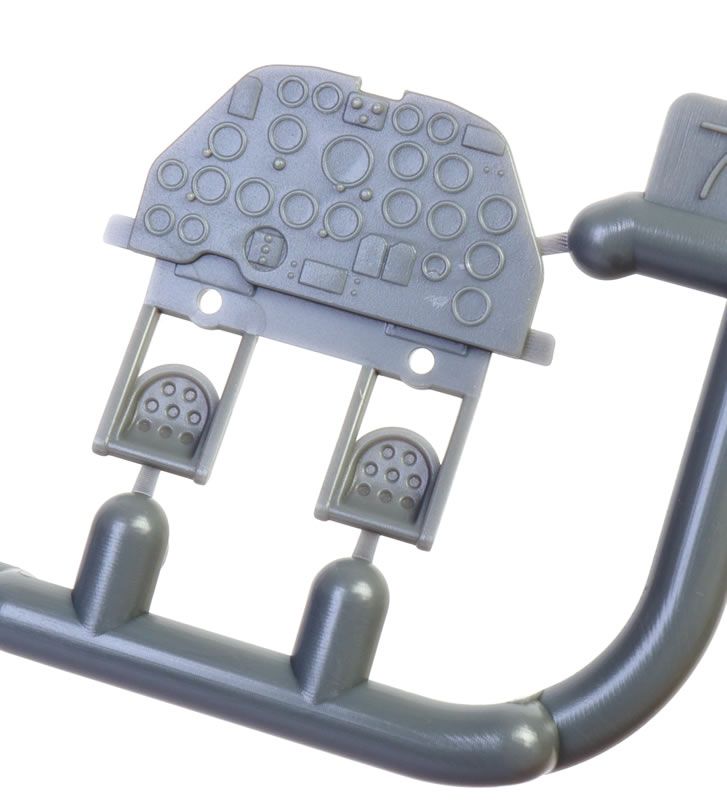
Decals are supplied for the instrument panel. These align perfectly over the raised instrument bezels. Harness strap decals are included too.
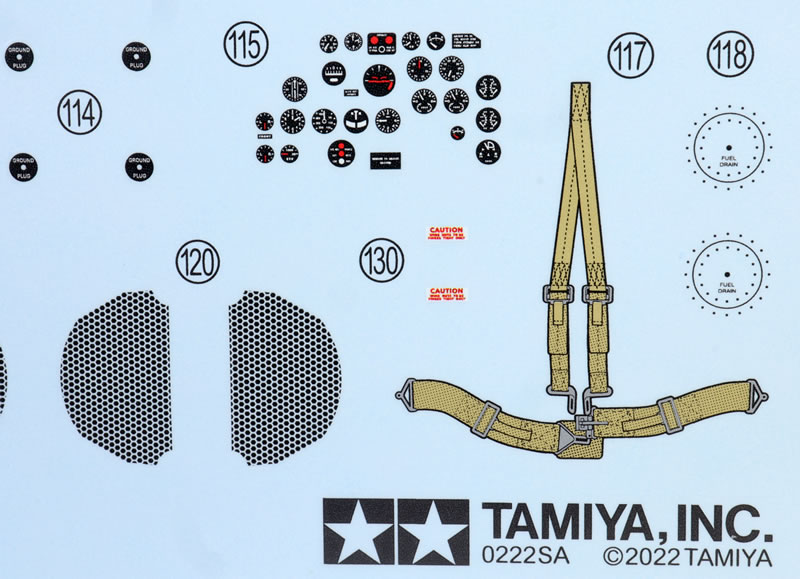
A nicely sculpted seated pilot figure is offered as an option for the cockpit.
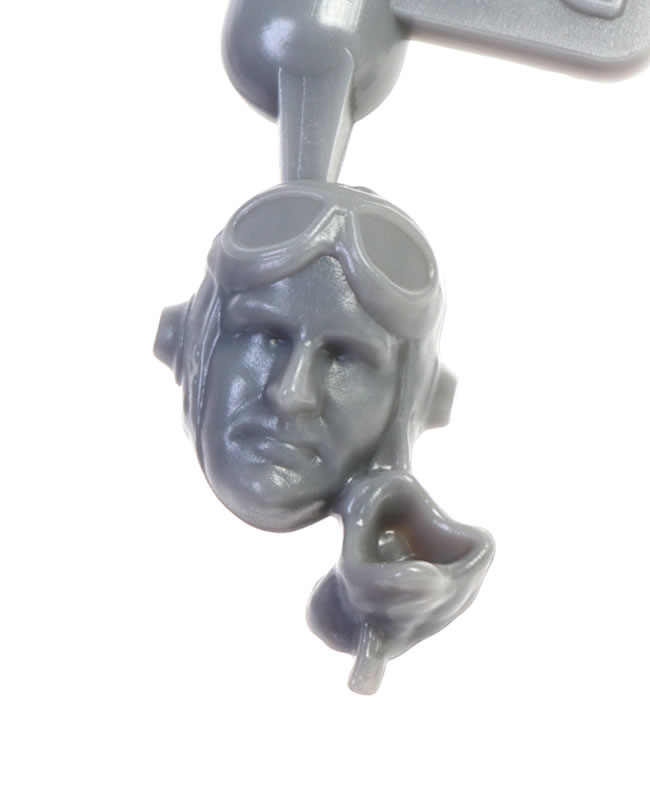
The assembled cockpit will be trapped between the upper and lower fuselage pods. The first of the three large chrome ball bearings is also fitted between the pod halves as nose weight.

Tamiya has moulded the wings with wide separate leading edge inserts. These permit multiple variants, including those with leading edge landing lights.
The wheel wells are busy with plumbing, rivets and other structural features. The completed wheel wells along with the other two nose weights are fitted between the boom halves. Interestingly, Tamiya has supplied the mesh boom intake grilles as decals.
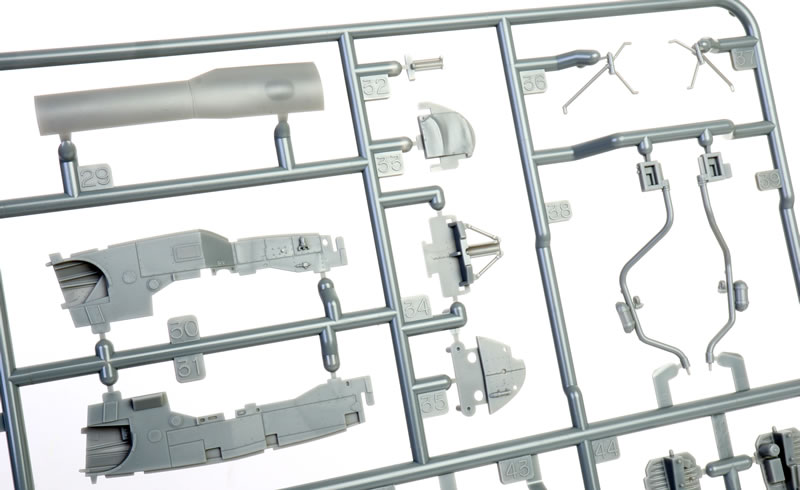
The completed booms are glued to the bottom of the engine nacelles and are locked into place with the large, one-piece horizontal tail surfaces (Part B7).
The booms are moulded with separate inserts at the bottom cowling area and a cover at the top.
Two styles of main wheel are offered - covered and spoked - although only the spoked seem to be relevant on these three marking options. The wheels are supplied in two halves each and they are neither bulged nor flattened.

Landing gear doors have been a commmon factor of frustration for those building the Hasegawa and Academy kits. Tamiya has addressed this challenge by moulding a mounting rail onto the hinges and doors, ensuring an easy and robust fit.
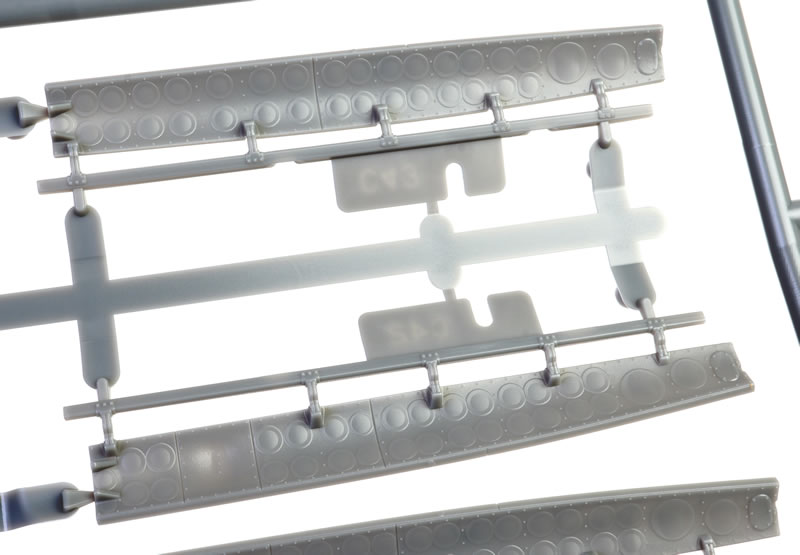
The crew boarding ladder may be built deployed or stowed.
The pilot's seat and the radio gear on the rear deck are fitted very late in construction. This is a good idea as they would risk being damaged or knocked off during assembly. I'll probably wait until I have finished painting the model until I install these. Decals are supplied for the pilot's harness.
The counter rotating propellers are correctly depicted. Make sure you attach these to the correct sides!
Canopy parts are thin and clear. Two styles of canopy are included, and they both may be posed open or closed. Both canopies feature the framed rear section.
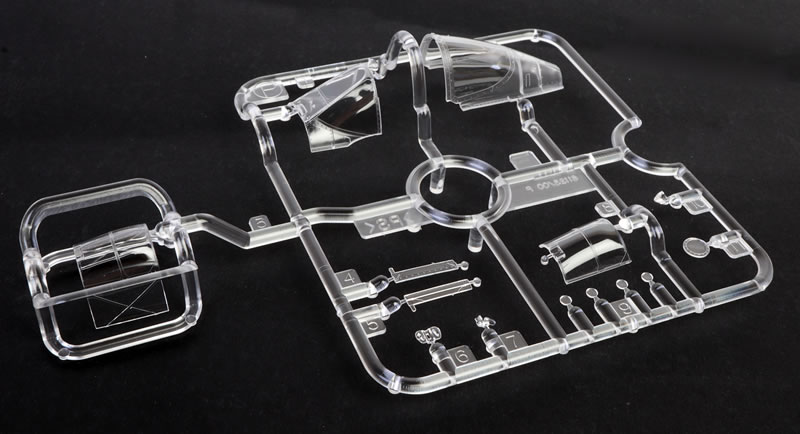
Self adhesive masks are provided for the canopy.
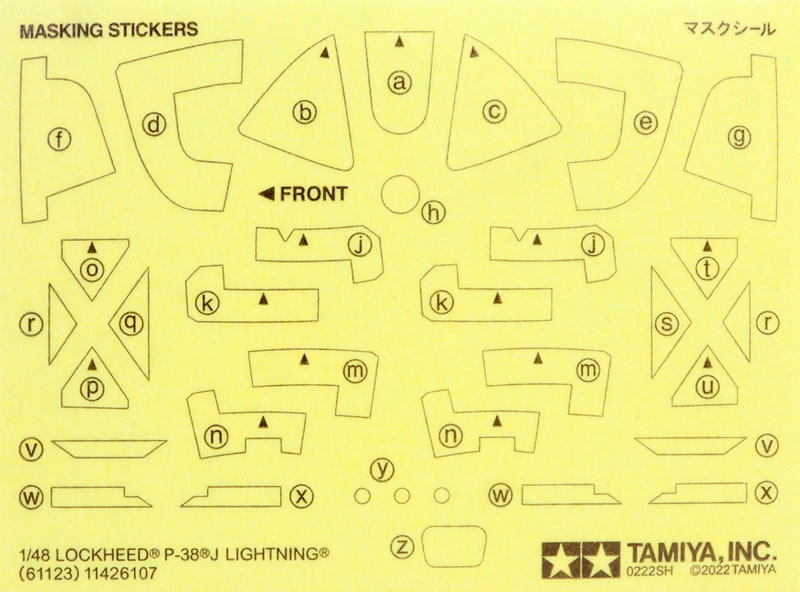
As is usual with Tamiya masks, the outlines are printed onto the Kabuki-tape masks and the modeller is required to cut out the shapes. I used a sharp hobby knife on mine and had no problems at all.
Markings
Markings are supplied for three aircraft.
All three aircraft are finished in the overall natural metal, although some panels on these Lighnings were puttied, sanded and painted silver. Check your references. Full colour, double-sided A3 marking guides are suppied for each aircraft.
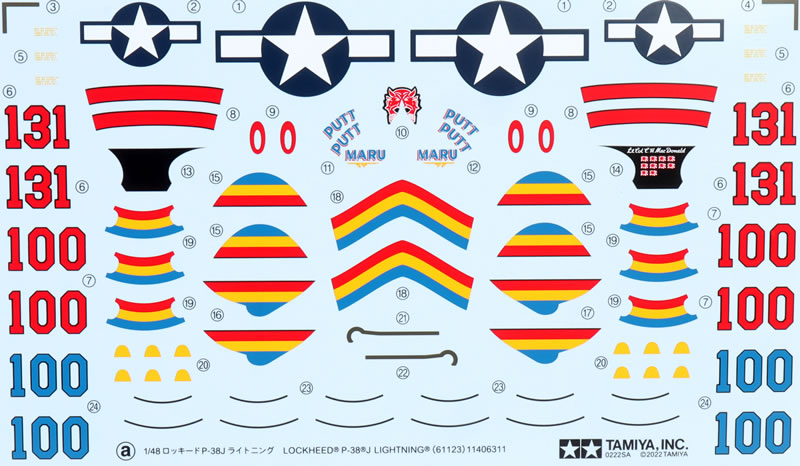
Each of the options feature a big A3 folded sheet with instructions for painting and markings. Two decal sheets are included.

Nice shiny mirror decals are supplied on the sheet, including the unique oval mirrors on the lower inboard enegine nacelles. Nice touch.
Decals are also offered for some of the exterior textures including the intake mesh and fuel fillers.
Printing, colours and registration is perfect on my sample.
Tamiya has once again woven its magic, expanding its Lightning family to now include the definitive P-38J model.
Tamiya's forerunners from Hasegawa, Academy and Monogram have all been notoriously difficult to build. Tamiya, however, has a happy knack for producing a kit that looks good on the sprues but gets even better when you start building it. This one is no exception. Having built the previous P-38F/G release, I can assure you from first hand experience that assembly will be a pleasure.
There is nothing fancy about this kit - no engine to display, photo-etch or moving parts. What we have instead is a delightfully detailed and accurate model that will go together without any drama.
Detail in the wheel wells is some of the best that I have seen anywhere. The cockpit also looks significantly better assembled than it does flat on the sprues.
There are plenty of inserts but don't be alarmed - fit is perfect. You will be hard pressed to pick a join line from a recessed panel line.
Tamiya's new 1/48 scale P-38J Lightning is a worthy replica of this beautiful aeroplane. You can be confident that the kit will line up perfectly and fit together without any resistance too!
* Historical text adapted from Wikipedia
Purchased by the reviewer
Tamiya kits are distributed in the UK by The Hobby Company Limited
Review Text Copyright © 2022 by
Brett Green
Page Created 18 July, 2022
Last updated
21 July, 2022
Back to HyperScale Main Page
Back to Reviews Page |
